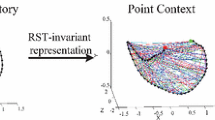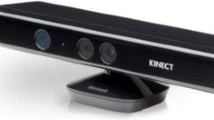Abstract
The measurement of similarity between two motion trajectories is one of the fundamental task for motion analysis, perception and recognition. Previous research focus on 2D trajectory similarity measurement. With the advent of 3D sensors, it is possible to collect large amounts of 3D trajectory data for more precise motion representation. As trajectories in 3D space may often exhibit a similar motion pattern but may differ in location, orientation, scale, and appearance variations, the trajectory descriptor must be invariant to these degrees of freedom. Shape context is one of the rich local shape descriptors can be used to represent the trajectory in 2D space, however, rarely applied in the 3D motion trajectory recognition field. To handle 3D data, in this paper, we first naturally extend the shape context into the spatiotemporal domain by adopting a spherical neighborhood, and named it 3D Shape Context(3DSC). To achieve better global invariant on trajectories classification, the adaptive outer radius of 3DSC for extracting 3D Shape Context feature is proposed. The advantages of our proposed 3D shape context are: (1) It is invariant to motion trajectories translation and scale in the spatiotemporal domain; (2) It contains the whole trajectory points in the 3DSC ball volume, thus can achieve global information representation and is good for solving sub-trajectories problem; (3) It is insensitive to the appearance variations in the identical meaning trajectories, meanwhile, can greatly discriminate the distinct meaning trajectories. In trajectory recognition phase, we consider a feature-to-feature alignment between motion trajectories based on dynamic time warping and then use the one nearest neighbor (1NN) classifier for final accuracy evaluation. We test the performance of proposed 3D SC-DTW on UCI ASL large dataset, Digital hand dataset and the experimental results demonstrate the effectiveness of our method.












Similar content being viewed by others
References
Bashir FI, Khokhar AA, Schonfeld D (2007) Real-time motion trajectory-based indexing and retrieval of video sequences[J]. IEEE Trans Multimed 9(1):58–65
Belongie S, Malik J, Puzicha J (2002) Shape matching and object recognition using shape contexts. IEEE Trans Pattern Anal Mach Intell 24(4):509–522
Chen L, Yao H, Sun X (2012) Action retrieval based on generalized dynamic depth data matching[C]// Visual Communications and Image Processing. 1–4
Cheng H, Dai Z, Liu Z (2013) Image-to-Class Dynamic Time Warping for 3D hand gesture recognition[C]// Multimedia and Expo (ICME), 2013 I.E. International Conference on. IEEE, 1–6
DEBOOR C, Fix GJ (1973) Spline approximation by quasiinterpolants[J]. Journal of Approximation Theory 8(1):19–45
Ding H, Trajcevski G, Scheuermann P et al (2008) Querying and mining of time series data: experimental comparison of representations and distance measures[J]. Proc Vldb Endowment 1(2):1542–1552
Doliotis P (2013) Viewpoint invariant gesture recognition and 3d hand pose estimation using RGB-D[J]
Doliotis P, Stefan A, McMurrough C. et al (2011) “Comparing gesture recognition accuracy using color and depth information,” in Proceedings of the 4th International Conference on PErvasive Technologies Related to Assistive Environments, pp. 20–22,ACM
Frome A, Huber D, Kolluri R et al (2004) Recognizing objects in range data using regional point descriptors.[J]. Lect Notes Comput Sci 3023:224–237
Grundmann M, Meier F, Essa I (2008) 3D Shape Context and Distance Transform for action recognition[C]// Pattern Recognition, 2008. ICPR 2008. 19th International Conference on. IEEE, 1–4
Kim I C, Chien S I. Analysis of 3D Hand Trajectory Gestures Using Stroke-Based Composite Hidden Markov Models.[J]. Applied Intelligence, 2001, 15(2):131-143
Jonathan A, Athitsos V, Yuan Q, Sclaroff S (2009) A unified framework for gesture recognition and spatiotemporal gesture segmentation. IEEE Trans Pattern Anal Mach Intell 31(9):1685–1699
Kaya H, Gündüz-Öğüdücü Ş (2015) A distance based time series classification framework[J]. Inf Syst 51:27–42
Li Z, Horain P, Pez A, et al (2009) Statistical Gesture Models for 3D Motion Capture from a Library of Gestures with Variants[C]// International Conference on Gesture in Embodied Communication and Human-Computer Interaction. Springer-Verlag, 219–230
Liang B, Zheng L (2015) A Survey on Human Action Recognition Using Depth Sensors[C]// International Conference on Digital Image Computing: Techniques and Applications. IEEE, 1019–1029
Lin WY, Hsieh CY (2013) Kernel-based representation for 2D/3D motion trajectory retrieval and classification[J]. Pattern Recogn 46(3):662–670
Liu W, Fan Y, Li Z et al (2015) RGBD video based human hand trajectory tracking and gesture recognition system [J]. Math Probl Eng 2015:1–15
Liu W, Fan Y, Lei T, Zhang Z (2014) Human gesture recognition using orientation segmentation feature on random Forest. In Proceedings of IEEE China Summit & International Conference on Signal and Information Processing (SIP’14), pp. 480–484, Xi’an, China, July
Lu G, Zhou Y, Li X et al (2016) Efficient action recognition via local position offset of 3D skeletal body joints[J]. Multimed Tools & Appl 75(6):3479–3494
Niu W, Long J, Han D et al (2004) Human activity detection and recognition for video surveillance[C]. IEEE Int Conf Multimed Expo 1:719–722
Psarrou A, Gong S, Walter M (2002) Recognition of human gestures and behavior based on motion trajectories. Image Vis Comput 20(5–6):349–358
Suzuki N, Hirasawa K, Tanaka K, et al (2010) Learning motion patterns and anomaly detection by Human trajectory analysis[C]// IEEE International Conference on Systems, Man and Cybernetics. IEEE, 498–503
Tombari F, Salti S, Stefano LD (2010) Unique shape context for 3d data description[C]// Proceedings of the ACM workshop on 3D object retrieval. ACM, 57–62
UCI KDD ASL Archive, http://kdd.ics.uci.edu/databases/auslan2/auslan.html
Vlachos M, Gunopulos D, Das G (2004) Rotation invariant distance measures for trajectories[J]. Proceedings of Sigkdd, 707-712
Wu SD, Li YF (2009) Flexible signature descriptions for adaptive motion trajectory representation, perception and recognition. Pattern Recogn 42(1):194–214
Xiao D, Zahra D, Bourgeat P et al (2010) An improved 3D shape context based non-rigid registration method and its application to small animal skeletons registration [J]. Comput Med Imaging & Graphics Off J Comput Med Imaging Soc 34(4):321–32
Xing Z, Pei J, Keogh E (2010) A brief survey on sequence classification[J]. Acm Sigkdd Explor Newslett 12(1):40–48
Yang JY, Li YF and Wang KY (2010) “Mixed signature descriptor with global invariants for 3D motion trajectory perception and recognition,” in Proceedings of the IEEE International Conference on Industrial Engineering and Engineering Management, pp. 1952–1956
Yang J, Li Y F, Wang K (2010) A new descriptor for 3D trajectory recognition via modified CDTW[C]// Automation and Logistics (ICAL), 2010 I.E. International Conference on. IEEE, 37–42.
Yang J, Li Y F, Wang K (2011) Invariant trajectory indexing for real time 3D motion recognition[C]// IEEE/RSJ International Conference on Intelligent Robots & Systems IEEE/RSJ International Conference on Intelligent Robots & Systems, 3440–3445
Yang J et al (2012) Mixed signature: an invariant descriptor for 3D motion trajectory perception and recognition [J]. Math Probl Eng 2012(1):488–488
Yuting Su1, Haiyi Wang1, Peiguang Jing1, Chuanzhong Xu. A spatial-temporal iterative tensor decomposition technique for action and gesture recognition[J]
Zhang Z, Tang P, Duan R (2015) Dynamic time warping under pointwise shape context[J]. Inf Sci 315:88–101
Zhao S, Chen L, Yao H et al (2015) Strategy for dynamic 3D depth data matching towards robust action retrieval[J]. Neurocomputing 151:533–543
Acknowledgments
This work is supported by National Natural Science Foundation of China (Grant no. 61501456), “Light of West China” Program of Chinese Academy of Sciences.
Author information
Authors and Affiliations
Corresponding author
Rights and permissions
About this article
Cite this article
Liu, W., Li, Z., Zhang, G. et al. Adaptive 3D shape context representation for motion trajectory classification. Multimed Tools Appl 76, 15413–15434 (2017). https://doi.org/10.1007/s11042-016-3841-0
Received:
Revised:
Accepted:
Published:
Issue Date:
DOI: https://doi.org/10.1007/s11042-016-3841-0




